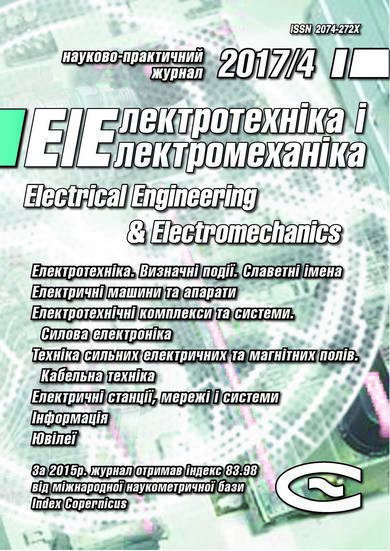GENERATOR ON ARCADYEV-MARX SCHEME WITH PEAKING OF THE PULSE FRONT IN ITS CASCADES FOR FOOD DISINFECTING
DOI:
https://doi.org/10.20998/2074-272X.2017.4.08Keywords:
generator of pulsed voltages, peaking of the pulse front in cascades of generator, working chamber, spark gap or switch, inactivation of microorganisms in food productsAbstract
Purpose. To obtain experimentally that the duration of the high-voltage pulse front is less than 1.5 nanoseconds on the load of a pulse voltage generator of less than 50 ohms in the form of more than two working chambers with a water-containing product. That increases the efficiency of disinfection of treated products. Methodology. To obtain high-voltage pulses in working chambers - the generator load - the pulse generation method was used according to the Arkadyev-Marx scheme. The pulses on the load were measured with a low-ohm resistive voltage divider, transmitted over a broadband coaxial cable, and recorded using a C7-19 oscilloscope with a 5 GHz bandwidth. The working chambers were filled with water and consisted of an annular body made of PTFE 4 and metal electrodes forming the bottom and the chamber cover having flat linings of food stainless steel for contact with the food product inside the chamber. Results. The high-voltage pulses on the generator load of about 50 Ohm or less have a trapezoidal shape with a rounded apex and a base duration of no more than 80 ns. The experimentally obtained pulse amplitudes on the generator load are up to 18 kV. As the load resistance decreases, the amplitude of the pulses decreases, and the duration of the front and pulse duration in general are shortened because of the accelerated discharge of cascade capacitive storages. Originality. For the first time we have obtained experimentally on the load of the generator in the form of three parallel working chambers with water, the active resistance of each of which is less than 50 Ohm, the pulse front duration tf≈1 ns. In addition, we have obtained experimentally a stable 9-10 channel triggering mode of the trigatron type spark gap in a five-cascade pulse voltage generator with a step-by-step peaking (exacerbation) of the pulse front in its cascades (GPVCP). Practical value. We have obtained experimentally the nanosecond pulse front duration on the GPVCP load and that opens the prospect of industrial application of such generators for microbiologically disinfecting treatment (inactivation of microorganisms in food) water-containing food products.References
1. Mesiats G.A. Impul'snaia energetika i elektronika [Pulsed power and electronics]. Moscow, Nauka Publ., 2004. 704 p. (Rus).
2. Boyko N.I. Generator on Arcadyev-Marx scheme in the mode with peaking of the pulse front in its cascades for food disinfecting. Tekhnichna elektrodynamika. Tem. vypusk «Problemy suchasnoyi elektrotekhniky», 2000, part 6, pp. 94-97. (Rus).
3. Barbosa-Canovas G.V., Gongora-Nieto M.M., Pothakamury U.R., Swansson B.G. Preservation of Foods with Pulsed Electric Fields. − Washington, San Diego, Academic Press Publ., 1999. − 200 p. doi: 10.1016/b978-0-12-078149-2.x5000-4.
4. Jasim Ahmed, Hosahalli S. Ramaswamy, Stefan Kasapis, Joyce I Boye. Novel Food Processing: Effects on Rheological and Functional Properties. CRC Press Publ., 2016. 510 p. Chapter 11. Pulsed Electric Fields for Food Processing Technology by Maged E.A. Mohamed and Ayman H. Amer Eissa. 2012. pp. 275-306. doi: 10.5772/48678.
5. Boyko N.I., Makogon A.V. Sposib obrobky ridyn i tekuchykh produktiv [The method of treatment liquids and fluid products]. Patent UA, no. 113592, 2017. (Ukr).
6. Beier M., Bek V., Meller K., Tsaengl V. Tekhnika vysokikh napriazhenii: teoreticheskie i prakticheskie osnovy primeneniia [Technics of high voltages. Theoretical and practical application bases]. Moscow, Energoatomizdat Publ., 1989. 555 p. (Rus).
Downloads
Published
How to Cite
Issue
Section
License
Copyright (c) 2017 N. I. Boyko, A. V. Makogon

This work is licensed under a Creative Commons Attribution-NonCommercial 4.0 International License.
Authors who publish with this journal agree to the following terms:
1. Authors retain copyright and grant the journal right of first publication with the work simultaneously licensed under a Creative Commons Attribution License that allows others to share the work with an acknowledgement of the work's authorship and initial publication in this journal.
2. Authors are able to enter into separate, additional contractual arrangements for the non-exclusive distribution of the journal's published version of the work (e.g., post it to an institutional repository or publish it in a book), with an acknowledgement of its initial publication in this journal.
3. Authors are permitted and encouraged to post their work online (e.g., in institutional repositories or on their website) prior to and during the submission process, as it can lead to productive exchanges, as well as earlier and greater citation of published work.





